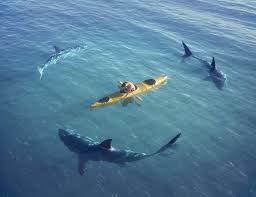
Father and son, Daniel and Tristan Sullivan, managed to swim about a mile back to shore after their two-man kayak was attacked, and sunk, by a shark on Tuesday.
The shark attack that sunk a two-man kayak off the west coast of Maui on Tuesday Opens in a new tab was a harrowing experience for a father and son, but they survived to share the story.
Daniel Sullivan, 45, and his son, Tristan Sullivan, 15, of Kula, were able to swim about a mile back to shore at the “thousand peaks” area after their kayak sunk, with no injuries.
That morning, they had decided to paddle out for some whale watching, said Daniel Sullivan during a virtual news conference Opens in a new tab this afternoon, in an area they were familiar with. It was a calm day, with a slight swell — and eventually, they saw a pod of humpback whales, including a mother, escort, calf, and two dolphins.
They were observing them from a distance, although the whales approached the kayak and then suddenly, as Daniel described it, there was a huge impact, and a large shark bit into the side of the kayak, just inches from his leg.
Sullivan, a professional photographer, said it all happened quickly — within minutes after he took a photo. He remembers a flash of white rising out of the water, and a huge set of teeth, and both he and his son were thrown into the water.
He recalls hitting the shark with the paddle to keep it away while in the water.
Though they tried climbing back into the kayak several times, they got flipped again, and it began to sink. Upon realizing this, they knew they would have to swim to shore, which took about 35 minutes at about 10 strokes at a time.
“The entire thing was pretty scary,” said Sullivan. “We feel really lucky to be alive, and grateful that we survived.”
Officials are still working on determining the species of shark that attacked and sunk the kayak, which was recovered after it washed ashore.
They will be examining it for bite marks, which measured 16-by-23-inches, but more importantly, swabbing it in hopes of recovering trace samples of DNA.
Carl Meyer, shark researcher with the Hawaii Institute of Marine Biology, said a DNA analysis would be the most definitive way to determine the species of shark. Based on initial observations of the bite mark on the kayak and Sullivan’s description of triangular-shaped teeth, he believes it was a white shark involved in the incident.
The only way to know, for sure, is to examine the DNA, a process that usually takes about a week.
Both tiger sharks and white sharks are present in Hawaii waters year-round, according to Meyers, but these attacks are still sporadic incidents, with “fundamentally low numbers” when looking at them over a longer period of time.
He said both tiger sharks and white sharks routinely take prey at the surface, and investigate floating objects that might be prey — such as boats, kayaks and surfboards.
Leave a Reply